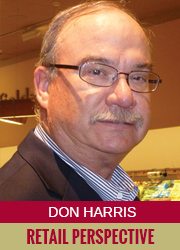At this time of year, discussions in the boardroom turn to the upcoming summer season and how to best drive sales throughout the store — especially in the produce department. In summer, produce will often ask for additional time to train personnel on how best to handle and display the seasonal items, especially highlighting soft fruits and melons. Management often balks at the suggestion — not realizing the sales potential to the overall operation. As a response to the produce representative’s request, management says, “They don’t need additional training; they just need to perform their assigned tasks — after all, it’s not art.” Once again this proves management “just doesn’t get it!”
 These requests from produce for additional training and direction on merchandising are not new for the summer selling season. These requests were made by produce people since the beginning of organized retailing. Over the years, these wishes have been met with acceptance and rejection — depending on the organization and the timing. It doesn’t matter whether they have been designated as training sessions, show and tells, merchandising seminars, or sales generation sessions — it all is the same effort. They are simply a designed session providing information and education on how best to display and promote the key summer items.
These requests from produce for additional training and direction on merchandising are not new for the summer selling season. These requests were made by produce people since the beginning of organized retailing. Over the years, these wishes have been met with acceptance and rejection — depending on the organization and the timing. It doesn’t matter whether they have been designated as training sessions, show and tells, merchandising seminars, or sales generation sessions — it all is the same effort. They are simply a designed session providing information and education on how best to display and promote the key summer items.
Summer is one of the most exciting times for consumers to experience the available produce varieties. The essence and taste of the season is available in one place. Peak-of-the-season product requires “peak-of-the-season” merchandising. To do the best possible job in this area requires demonstration and clear direction. Specific instructions on how to accomplish these types of displays to generate sales are vital for the inherent potential of these new seasonal items. This is not something that can be accomplished by simply reading the requirements of the task or following directions in a manual. To capitalize on summer produce properly requires tactile involvement of all the senses.
“The great benefit with this education is that by learning these techniques for these key seasonal items, the knowledge from this activity passes over to the building of displays in the department.”
How much time does it take to accomplish this instruction? A well thought out, organized presentation (utilizing your most experienced produce personnel) could be accomplished in basic training and education during the morning set-up. The method also establishes a routine to follow each day during this key selling season. This plan of action highlights the displays and the correct merchandising techniques for the key summer items to ensure maximum sales.
The great benefit with this education is that by learning these techniques for these key seasonal items, the knowledge from this activity passes over to the building of displays in the department. Granted, this has to be done in every store within the chain (and in the case of a very inexperienced crew, you might have to be repeat sessions), but it still seems like a very small investment that has a huge upside in terms of sales impact for, not only the produce department, but the entire store. The investment required in additional personnel and hours to conduct this training will prove to be a minimal cost compared to the sales that will be driven by this activity.
Efficiency and controlling of labor costs are good in theory, but often don’t prove as valuable in practice when applied to something as personal to the consumer as fresh produce. And make no mistake, buying produce is indeed a personal choice. By providing additional time to train the produce personnel to present the best of summertime fruits and vegetables, you not only set the stage for increased sales, but you also communicate the value, selection, and variety offered to your customers. When you look at this activity, it really could be considered “creating art.” This protocol allows the creativity of each employee to be expressed in the building, merchandising and maintenance of these displays. It allows for communication between the personnel to their consumers. By presenting customers with fresh and abundant displays of key seasonal items, produce personnel can inform customers about the best items offered at peak-of-the-season quality and taste. It seems such a small price to pay for the ability to “create art” in the produce department.
Don Harris is a 41-year veteran of the produce industry, with most of that time spent in retail. He worked in every aspect of the industry, from “field-to-fork” in both the conventional and organic arenas. Harris is presently consulting and is director of produce for the Chicago-based food charity organization, Feeding America. Comments can be directed to editor@producebusiness.com.


